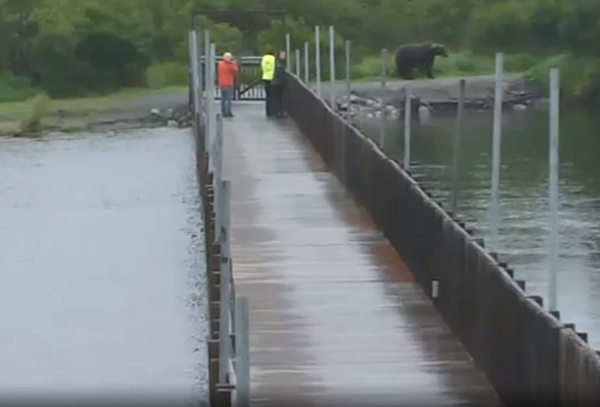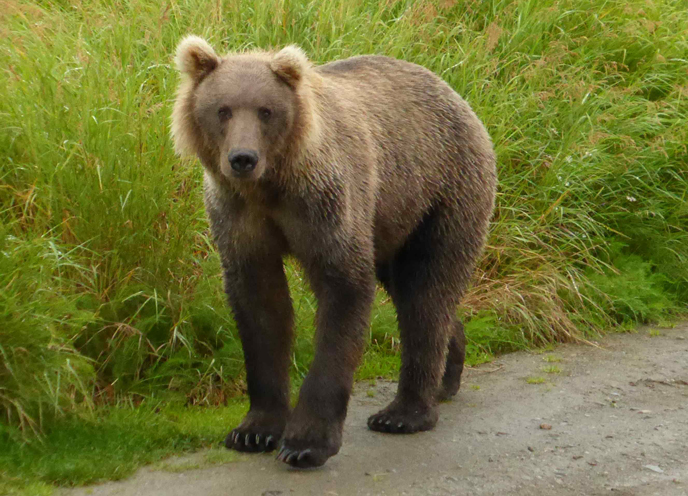
Occasionally, while you are watching the bearcams you may see people on the floating bridge while a bear is nearby. The people in the photo above were not behaving appropriately for the unique bear viewing opportunities at Brooks Camp. The wildness of the bears and the wonderful experiences for people at Brooks Camp is dependent on everyone giving bears space.
The floating bridge across Brooks River is not a safe wildlife viewing platform. The bridge is closed when bears are within 50 yards of the bridge. Bears can climb onto it and tear the wooden railings off of it. People are often surprised by bears in and around Brooks Camp. However, the behavior of the people in the photo below suggested that they weren’t very concerned about safety.
They were spread out and taking many photos while the bear walked by, instead of bunching up together in a group or moving away. They also continued to watch bears from the bridge afterward. Certainly, there are situations when you should stand your ground when a bear is close. At Brooks Camp, however, unless you are being charged by a bear then moving away from the animal is almost always the better choice.
When a bear is within 50 yards (~46 meters) of the bridge, it isn’t closed solely for safety concerns. It is closed to ensure that bears have free access to the river. Some bears, and admittedly not the bear in the photo with the people, will not move through areas with groups of people standing in their way.
On August 27th, I was alone on the wildlife viewing platform at the lower Brooks River. A subadult bear approached the platform, but when it saw me, it stopped, turned, and walked through the marsh behind the platform. It appeared that my presence was enough to alter the bear’s movements.

This bear noticeably reacted to the author's presence on the wildlife viewing platform even though he was quiet, standing still, and alone.
Bears like this one are likely at a disadvantage at Brooks Camp. Not only do they have to compete with other bears for access to food, but in their minds people as well. For bears that show little tolerance towards humans, a person occupying a spot in the river or even standing on the viewing platforms may be a competitor. Their relative intolerance of people may force them to less desirable places to feed, or they may abandon the area altogether. They are more likely to use the area if people are consolidated in tight groups and bear view from predictable places, like the viewing platforms that the cams are attached to. More information about this dynamic can be found at this link: http://www.bearsmart.com/paper/432.
You could argue that Katmai is a big park and bears could feed somewhere else without people. That might be true, but it is also likely that some bears fishing along the Brooks River do so because they know of no other place to fish at this time of the year. Maintaining an appropriate distance from bears is not only good for our safety, but it also helps to ensure that bears have free access to the resources they need to survive.
In contrast to the subadult I encountered, other bears at Brooks Camp, like 410, appear to be very tolerant of people and are often described as human-habituated. In areas of high bear densities and high quality food sources, some bears become habituated to our presence. Habituation is simply defined as getting used to something. These human-habituated bears, while giving us remarkable opportunities to observe their lives are also more likely to become food conditioned (seeking food from people) and associate our possessions with play toys.
Bears that damage human property or seek food from people lose in the end, especially if they wander outside of the park where they are given less leniency. Every summer, bears are killed in King Salmon and Naknek in defense of life and property, and some of these bears may have had previously benign experience with people at Brooks Camp. No bear has been killed at Brooks Camp since 1983, precisely because of strict food and gear storage regulations. Wildlife distance regulations help to ensure that as well.
Everyone who arrives at Brooks Camp is required to attend a short bear safety talk explaining the rules designed to protect people and bears. It also explains the special situations that visitors will encounter, like bears around the bridge. No rangers were on duty at that time the photo above was taken (we have to go home sometime, of course). Whether or not rangers are working, it is everyone’s responsibility to protect bears and the unique and special experiences at Brooks Camp.
